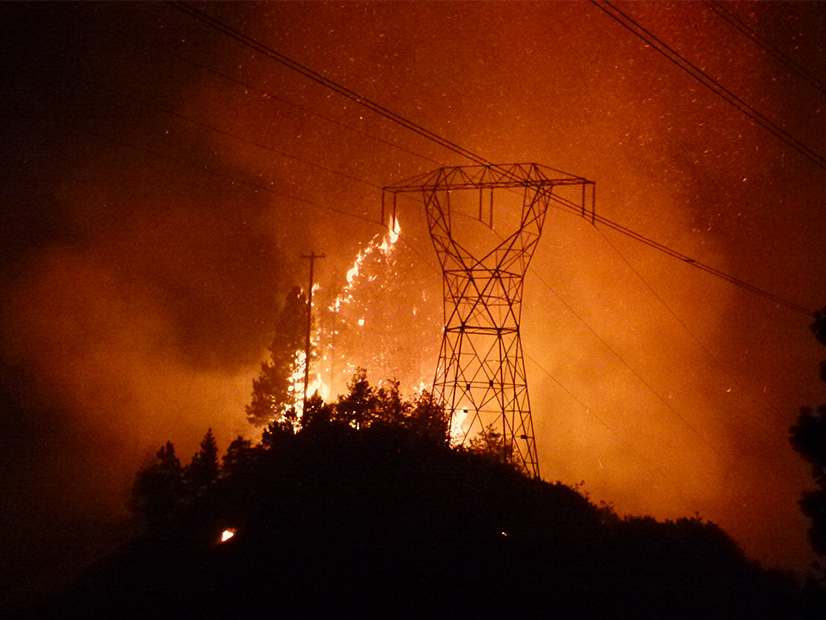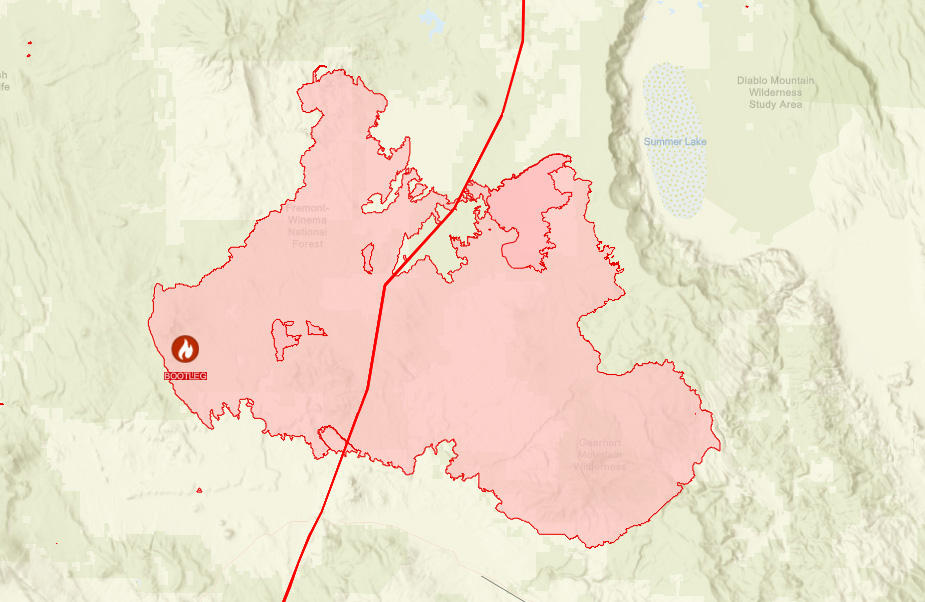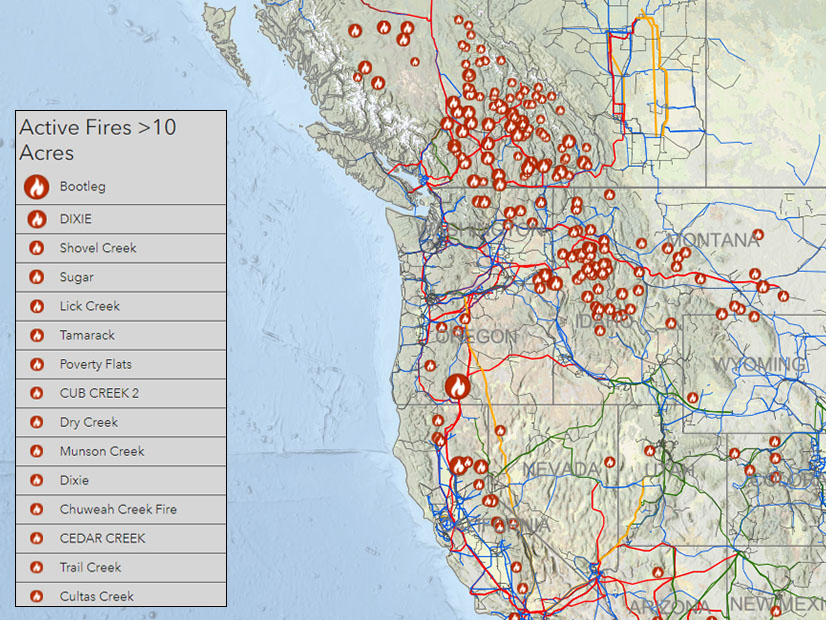
The near shutdown of the California-Oregon Intertie by a wildfire last month renewed concerns about the vulnerability of major transmission pathways to wildfires and the disruption of vital supply lines in the Western Interconnection.
The Bootleg Fire in southern Oregon burned under and around the Pacific AC Intertie (PACI) in early July, severely derating it. The PACI consists of three parallel 500-kV lines that deliver power from Columbia River hydroelectric dams to Northern California.
The PACI’s towers are 125-150 feet tall, on average, in a right-of-way wide enough to be seen from space. The safe distance keeps conductors clear of fire. The derate was caused by thick smoke, which can cause arcing on the lines, and the need to protect the safety of fire crews on the ground, officials with CAISO and the Bonneville Power Administration, which runs the lines, said at the time.
The incident also limited transmission on the Pacific DC Intertie (PDCI) connecting Oregon to Southern California via Nevada. The derate was meant to prevent overload on the PDCI, which can serve as a relief valve for the PACI.

As a result, CAISO declared a Stage 2 energy emergency on July 9 while it grappled with the loss of nearly 4,000 MW during a moderate heat wave, narrowly avoiding blackouts. (See CAISO Declares Emergency as Fire Derates Major Tx Lines.)
“The fire in Oregon which took out the big transmission lines leading down to California was a very extreme event,” CAISO CEO Elliot Mainzer said Friday in a media briefing on supply issues. “It didn’t last very long, but it was an event that we think is likely to become more frequent in the future.”
As of Monday, the Bootleg Fire was still burning at about 414,000 acres and was about 84% contained.
‘Disasters that Reduce Transmission’
Fires affecting transmission lines are nothing new. In the past, such blazes were a prime concern for stakeholders in the West. But lately, the danger of wildfires to transmission lines has taken a back seat to concerns about power lines starting fires and the need for public safety power shutoffs (PSPS).
The July incident raised old concerns anew, said Dede Subakti, CAISO vice president of system operations.
“We saw firsthand on the weekend of July 9 that wildfires, even those in another state, can affect supplies in California,” Subakti said. “Because we are in an interconnected grid, natural disasters that reduce transmission capability can impact our system.”

The Western Electricity Coordinating Council (WECC) maintains a wildfire dashboard that coordinates information about fires from official sources with a map of high-voltage lines in the West. Last week, for instance, it showed 71 transmission lines threatened by wildfires, including seven 500-kV lines in the Western U.S. and the Canadian provinces of British Columbia and Alberta.
WECC, which has primary responsibility for ensuring Western reliability, declined to make any of its experts available for interviews. Spokesperson Julie Booth sent RTO Insider an email referencing the reliability organization’s recent webinars on wildfires, which focused primarily on public safety power shutoffs, and said it had begun an information-gathering process among some of its stakeholders.
“In addition to our two wildfire preparedness webinars in May that included best practices and lesson learned, we have also initiated a wildfire data request to select entities within the [Western Interconnection],” Booth wrote. “The request is an attempt for WECC to better understand how wildfires and public safety power shutoffs have affected the reliable operation of the Western Interconnection. We expect to analyze and discuss the findings in early October.
“Additionally, we will continue to closely monitor wildfire activity and its impacts on the bulk power system through our situation awareness function,” she said.
Drought Dangers
At about the same time as the Bootleg Fire was advancing toward the PACI in Oregon, large wildfires were burning in Arizona, where transmission lines cross the state in a big “X” centered on Phoenix.
In WECC’s wildfire webinar in May, Wade Ward, fire mitigation specialist with Arizona Public Service (APS), warned of a potentially dangerous summer after years of drought.
“If you look at any of the indices across the Southwest, certainly the potential is there for some very large and frequent fires this year,” Ward said.
The state’s vast ponderosa pine forests sit atop the Colorado Plateau, the site of massive wildfires in prior years. The blazes included the state’s largest wildland blaze, the 538,000-acre Wallow Fire in 2011, and the 469,000-acre Rodeo-Chediski Fire in 2002. Both fires derated APS lines, Ward noted. (See Western Drought Increases Wildfire Risks.)
Trees on the Mogollon Rim, which marks the southern edge of the plateau, are so stressed by drought that they are bursting into flames during controlled burns by the U.S. Forest Service intended to reduce ground fuels near power lines, Ward said.
Mainzer said Friday that the West faces daunting challenges from drought, wildfires and tightening supply as states transition from fossil fuels to renewable resources.
“Earlier this year I expressed guarded optimism that our grid was more prepared for the summer, while acknowledging that extreme West-wide heat was still a significant risk,” Mainzer said during Friday’s briefing to discuss an emergency proclamation by Gov. Gavin Newsom to free up resources and increase generation. (See related story, Calif. Governor Proclaims Emergency as Blackouts Loom.)
“But over the course of the past three months,” he said, “as we’ve experienced worsening drought conditions, a declining hydro production, unprecedented heat throughout the West and increasingly dangerous wildfires impacting key transmission lines, it’s become clear that we’ve entered a new normal and that extraordinary action is required.”


